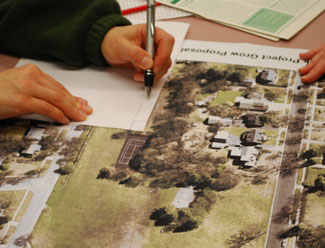Project Grow Gardens at Hunt Park?

The hand wielding the pen belongs to Amy Kuras, a city of Ann Arbor park planner who was sketching out roughly to-scale plot sizes for potential gardens, in the area south of the tennis courts where they are proposed. The aerial view photo of Hunt Park is oriented in this photograph looking from north to south.
With snow on the ground outside and temperatures around 10° F and headed even lower, a dozen people gathered in the 5th-floor conference room of the Larcom Building to talk about warmer days ahead: a possible new Project Grow garden at Hunt Park, which could be implemented as early as this spring.
Amy Kuras, park planner for the city of Ann Arbor, and Melissa Kesterson, executive director of Project Grow, were joined at the meeting by neighbors of the park, which is located in the block bounded by Sunset, Spring and Daniel streets. Councilmember Sabra Briere, whose Ward 1 includes the park (it’s right on the boundary between Ward 1 and Ward 5), attended the meeting as well.
Kesterson had an easy pitch to make to the gathered neighbors – the meeting was sparked by their own interest in seeing a community garden in Hunt Park. The Park Advisory Commission had directed city staff a few years ago to begin identifying potential locations for community gardens in city parks. With neighborhood buy-in, Kuras said, no special resolution by city council or PAC would need to be passed in order to make the Hunt Park gardens a reality. In other parks over the last couple of years, Kuras said, there has not been adequate support for gardens – in fact, there’d been opposition.
Key to the neighbhood buy-in for Hunt Park gardens was the location within the park: to the south of the tennis courts and just east of the tree line that runs down the center of the southern part of the 7-acre park. The space, which could accomodate 6 to 8 gardening plots, was identified by neighbors as the best location within the park as far as neighbhood support. The space to the north of the tennis courts, for example, would be a non-starter, they said, because it’s heavily used as a soccer field. While the proposed space is under-used, one neighbor said it was not completely un-used: she and her friends used it for volleyball. Still, she said that this was not an impediment to her support of the garden there.
The location in the area just south of the tennis courts is also dictated partly by the requirements of gardening: the topography of a steep hill on the park’s north end founders on the basic requirement of flatness. The proposed location easily meets most other basic criteria used by Project Grow to determine suitability – like sunlight, availability of at least some parking options, and overall ease of access for gardeners – except for one: access to water. There is water available in the park roughly 400 feet north of the gardening location, but running a garden hose that distance did not capture the imagination of anyone in the room.
Kuras said that she could not imagine that the city would pay to put in a permanent water line, but that it’s something that could be done. Kesterson gave the Project Grow garden at Greenview as an example of a permanent water line that had been installed (from a fire hydrant) and paid for by Project Grow. Another option is to simply install a second city water meter at someone’s house (nearer to the proposed garden location) who would agreed to allow it.
In the short term, Kuras said that a conversation between Kesterson and the city’s field operations staff could better determine what options might be available for filling water barrels at the site that gardeners could use to water their plants. Based on Tuesday evening’s meeting, it appears that Project Grow will move forward and try to make gardening plots available for spring 2009, treating the challenge of water supply as a problem to be solved.
Among the neighbors gathered, five or six indicated they’d be interested in renting a plot at Hunt Park. Although they would receive no preferential treatment in allocation of plots – Project Grow plots were fully subscribed last year with a wait list – they had a defacto advantage in knowing about the Hunt Park location, because the site is not yet a part of Project Grow’s written materials.
Plot sign-up for the rest of Project Grow’s locations is underway, said Kesterson. Gardeners who rented a plot in the previous year are guaranteed the same plot only if they submit their application by March 15. Kesterson said she’d already received applications from hopeful new gardeners, who will be assigned plots on a first-come, first-served basis. After the meeting, Kesterson said she wanted to “gently urge” gardeners from last year who wished to garden the same plot to get their materials and applciation fees turned in.



